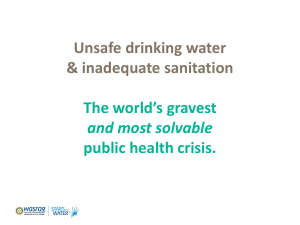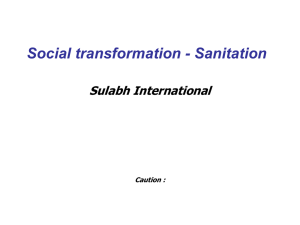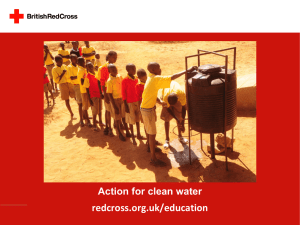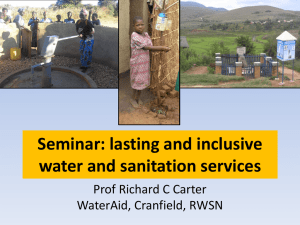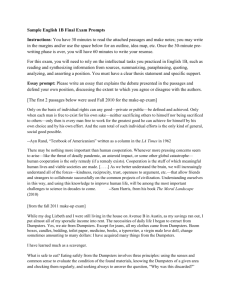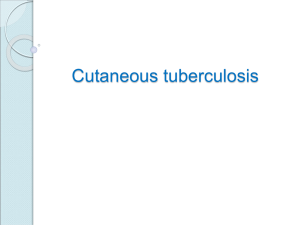read more - CHIP-IN
advertisement
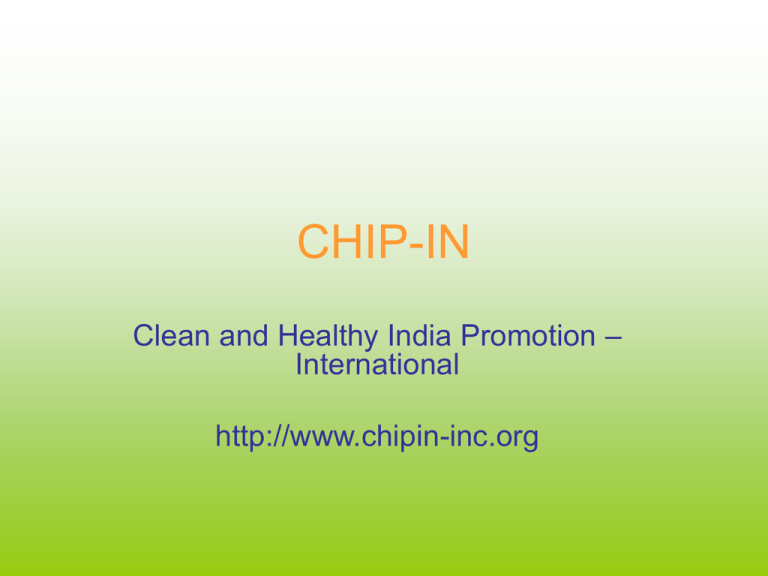
CHIP-IN Clean and Healthy India Promotion – International http://www.chipin-inc.org Tax Deductable Charity work • During your next trip to India you can take the message to your School, Community or old work place. • Improve their health and thereby wealth. • Get tax deduction in USA, on your Air ticket, Hotel and food etc. AIM • To improve the sanitation In India by education. • For all to participate in cleaning India. It is everyone’s responsibility, not just that of servants and cleaners. • Anti littering, anti spitting, open urination and defecation campaign. • Gain government involvement to implement some major changes in the present practice of waste disposal, e.g. Dumping sewage in rivers and Indian Railways dumping human excreta on the tract. Access to Sanitation Country Open defecation Mexico USA CHINA INDIA Rural 12% 0% 2% 69% Urban Total 2% 4% 0% 0% 6% 4% 18% 54% http://apps.who.int/ghodata/ Statistics for 2008 Popul.improved Sanitation 85% 100% 55% 31% Communicable diseases • Tuberculosis: spitting. All+ve. • Mosquito born diseases: Malaria, Dengue fever, Chicken Guinea, Encephalitis Epidemics. • Feco-oral (Water) contamination: Amebiasis, Cholera, Typhoid, Intestinal worms, Hepatitis A, • Rodent born: Plague • Air born: Asthma( Trop. Pulm. Eosinophelia), Pneumonia and TB. Stat. on Health. WHO, 2009 COUNTRY LIFE ADULT STUNTED • Mexico USA CHINA INDIA exp. Mort. > 5yr 76 78 74 64 121 108 115 215 15.5 3.9 21.8 47.9 TB HIV- 2 0 15 26 Adult Mortality: Probability of dying 15-60yr/1000 population Tuberculosis (HIV-ve): Per 100,000 population Stunted>5yr:Percentage Death>5yr:Percentage of all cause mortality. DIARRHEA Death 4.7 3.9 10.5 19.8 Why we need change? • Health and Economic cost. -$53.8 billion ( 6.4% GDP)/Year. World Bank (2006) Hurricane Katrina $ 20,billion.(Worse in US history) Hilton world wide 3500 hotels = $20 billion State income Andhra pradesh,2006-7= $54.5 billion State income Tamil Nadu,2006-7= $53.7 billion State income Gujrat,2006-2007= $ 48.3 billion -India spends 3.4% GDP on health care. -91.4% of health care cost is paid privately. - Majority of sickness in India are aftermath of poor sanitation. Their eradication will save big money to families. Diseases and Cost WHAT IS BEING DONE • Total Sanitation campaign, Ministry of Rural Dev., India.: Effective. • National Urban Sanitation policy, Ministry of Urban Dev., India.: Not as effective. • Multiple NGO for clean water. • Multiple NGO running Hospital and clinics. • Free eye camps. CONVENTIONAL STRATEGY • PRIMARY PREVENTION: To prevent disease from occurring: vaccination, water filter, Odomos, mouse trap, Mosquito nets, controlling salt and fat in diet, Physicals, Mammogram etc. • SECONDARY PREVENTION: Treating Hypertension, Diabetes, osteoporosis, Tuberculosis exposure ,tummy worms, • TERTIARY PREVENTION: Preventing further complications of disease. Like prevent repeated heart attack, stroke, tuberculosis, diarrhea, cholera, malaria CONVENTIONAL STRATEGIES NOT WORKING • PRE PRIMARY PREVENTION NEEDED: • So water in not infected. • So there are no flies, mosquitoes and mice. • So Air is not polluted. (ALL CAUSED BY BAD SANITRAY PRACTICES) • This will help PRIMARY,SECONDARY AND TERTIARY PREVENTION to succeed. EDUCATION • Educate on germs, can not be seen but cause diseases. • Anti littering campaign. Main cause of dirtiness. • Bag house hold garbage. Bin liners, Plastic shopping bags. • Throw in Dumpsters only, or Far away from homes. • Safe food handling. Use gloves and tongs. • How do we get feco oral contamination. Public defecation and Urination ultimately gets in food and water, that we consume. • How spitting spreads Tuberculosis. • How do we get mosquitoes and related diseases. • How does dirty surrounding brings in mice ,mosquitoes and diseases back in home, through them. TOOLS • Garbage bins and Dumpsters for Indian situation: – Made of thick plastic or other cheap material to avoid theft. – Multiple holes, to avoid water collection and mosquitoes and flies. • Gloves (McDonalds). • Bin liners. (Plastic shopping bags) • Tongs and grabbers Dumpster (Two Pieces) Dumpster (Assembled) Bins Segments of Campaign • CHIP-IN and NGOs: – Volunteers to educate, Monitor and mentor. – Private sponsorships, Adopt a Street etc. • Local Govt.: – Education: Cinemas, Posters, – Provide: Sulabh Shauchalaya (Mutralaya), Dumpsters, Trash bins. – Regulate: Safe food handling: Gloves, Covers • State Govt.: – Education: School Curriculum (more effective), TV and radio. – Tax exempt: Sulabh Shauchalaya, septic tanks – Enforce: Reward and punish. Fine) • Central Govt: – Clean Rivers: Safe waste disposal. – Tax promotion for Sanitation projects like Septic tank and Sulabh shauchalaya, Dumpsters and Bin liners and other sanitary equipments. – Indian railway to change its toilets in train. Do not dump on tracts. Funding • Local businesses can be asked to sponsor bins and dumpsters. • Cleaners can be paid directly by the sponsor for bin liners and cleaning. • Local government help where no sponsor is available. • National Sanitation is a potential $152 billion market.64% for infrastructure and 36% operation and maintenance.( World Bank). CHIP-IN INITIATIVE • Education on germ and hygiene is the key. • Any one living in the west knows the basic sanitary practices: – – – – Not littering. Bagging. Not depending on servants, and clean them selves. Keeping the back yard clean, not just the front. • Use these “Trained volunteers” to help educate these practices during their personal visit to India. • Tax deduction is a bonus besides self satisfaction CHIP IN (Details) • • • • Any one going to India on personal trip . Download curriculum from CHIP-IN web site. Must make presentation in the institution. join the students in cleaning the premises (Optional). • On return, they get a certificate, that will make a portion of their trip tax free.( Will be more than the registration fee, in most cases.) • Encourage them to be the Ambassador to that school, and follow up.



